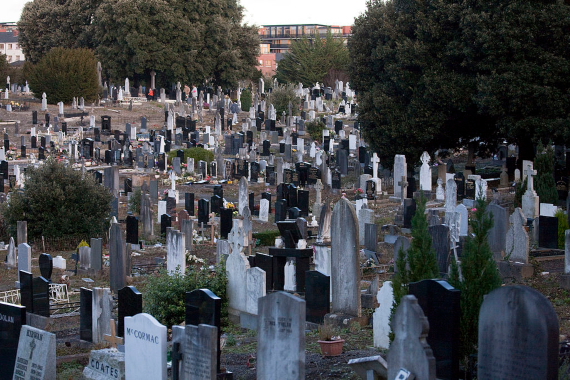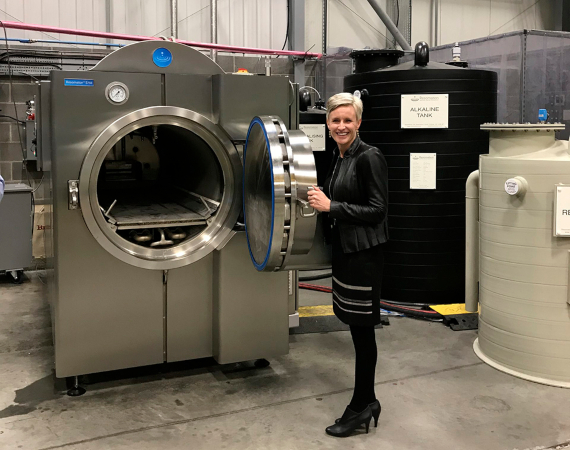Nearly 59 million people died worldwide in 2019, and it is estimated that by the end of this century the annual number will double. The Population Reference Bureau in Washington estimates that about 100 billion human beings have died in the entire history of our species. And while it is clear that humanity’s ever-increasing population has a significant environmental footprint, it is equally clear that each of us leaves behind another footprint when we depart the realm of the living: toxic substances used in the embalming process, greenhouse gases emitted in cremations, the consumption of resources for the manufacture of coffins and the occupation of valuable land space. All this adds up to an environmental impact that we don’t normally take into account, that of death. Nowadays, it is one that we can mitigate thanks to a growing number of options for greener burials.
Death is something we living people don’t like to think about, so it’s not uncommon for the day to arrive without having planned what fate we would like for our mortal remains. In 2017, a survey by the National Funeral Directors Association (NFDA) in the US revealed that while two-thirds of Americans consider it important to instruct family members as to their interment wishes, only 21% actually get around to doing so. But for the more forward-thinking among us, innovative offerings have emerged in recent years in addition to the traditional options of burial or cremation. And in the context of a growing environmental awareness, some of them specifically seek to reduce the ecological impact of the process.
The environmental footprint of death
But what exactly is this impact? Perhaps also because of the taboo that death inspires in us, the truth is that it has been a poorly studied field. “During our research, I was surprised at how little research has been done comparing the ecological footprints of the various kinds of burial and disposal methods for human remains,” University of Kansas environmental sociologist Paul Stock tells OpenMind.
One of the few recent studies in this field, undertaken by researcher Elisabeth Keijzer of the innovation and sustainability consultancy TNO, found that cremation is only slightly more environmentally friendly than conventional burial when all the impacts involved are balanced out, but that neither option clearly wins on all of them. Burial is especially penalized for its land use. The study concluded that, in any case, “the total impact can be quite small in comparison to other human activities.” Other estimates have calculated that a cremation produces about 400 kilograms of CO2—along with pollutants such as dioxins and mercury from fillings—and consumes the energy equivalent of an 800-kilometre car trip.

This relative lack of scientific research on the environmental impact of death translates into a certain lack of public awareness; not even long-time environmentalists over the age of 60 are aware of green burial options, according to a study published by Stock in the journal Mortality. Generally, these middle-aged activists prefer cremation to avoid the ecological cost of burial. However, according to the NFDA, there is a growing interest in green burials, an option that more than half of those surveyed would consider.
The back-to-the-basics option or water cremation
The environmentalists interviewed by Stock have a wide range of options available to them, as the state of Kansas has been a pioneer in green burials. The most basic option, natural burial, is available at the local Oak Hill Cemetery. This model forgoes formaldehyde for embalming, as well as the use of metal, concrete and plastic, using only biodegradable materials. Often the body is simply wrapped in a cotton shroud to facilitate decomposition. The natural landscape is modified as little as possible and graves are marked with locally sourced flat stones.
In addition to this back-to-the-basics option, others opt for innovation. One of them is alkaline hydrolysis, also called water cremation, aquamation or resomation. The method consists in placing the body in a tank with an alkaline solution at high temperature that accelerates natural decomposition. The process is completed in a few hours, producing bone powder that is returned to relatives.

As Sandy Sullivan, founder and director of the company Resomation, tells OpenMind, a study by the Dutch company TNO puts the carbon footprint of resomation at six times less than cremation, using seven times less energy and no emissions or release of mercury. The process is already legal in 20 US states and four Canadian provinces, and is in the process of being legalised or regulated in several European countries.
Convert the human body into compost
Resomation is a candidate to become an alternative to traditional methods, but it is not the only one. Companies such as the US-based Recompose offer to convert the human body into compost—organic fertilizer—which can be kept or used to plant a tree. This option has been legal since 2020 in the state of Washington, where the company is headquartered, although it’s legalisation has yet to be extended to other places. The Swedish company Promessa is also working on a process to produce fertile soil by freezing, fragmenting and freeze-drying the remains.
In short, green burials are now a growing trend. However, as with any boom, it is possible that not all the new offerings live up to their claims. As Keijzer emphasises to OpenMind, full life-cycle analyses show that the difference in the environmental impact of traditional burials compared to some of the innovative options now available is not quite as dramatic as we might perhaps imagine.
“For me, keeping in mind people’s strong ties to familial or religious traditions, my choice would be to be buried simply in the ground without a casket or gravestone,” Stock concludes. “Yes, this requires land in the form of cemeteries of some sort, but those lands can serve as carbon sinks as well as places for family and friends to come and honor the dead.”
Comments on this publication